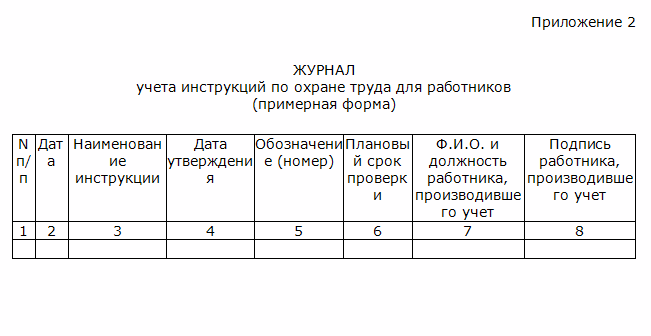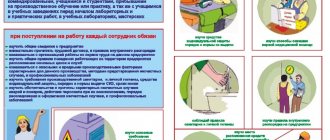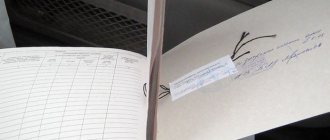The journal for recording the issuance of labor protection instructions is an important document for recording the information and distribution of labor protection instructions to employees. Each company within whose walls they engage in production may have a similar document. At least this is stated in the laws relating to the Labor Code. Controlling organizations strictly monitor this.
- Form and sample
- Free download
- Online viewing
- Expert tested
FILES
Why is it needed?
The journal is a way to reflect to whom and in what form labor safety instructions were issued. If an accident occurs at work due to failure to comply with labor safety instructions, the employee responsible for informing others may incur both administrative and criminal liability for failure to fulfill his duties. The completed log book impartially records who issued what and to whom, and whether briefing was carried out with a specific team member.
Having such proof of the fulfillment of their duties in hand, the manager, foreman or other person responsible for industrial safety minimizes their risk of going to prison by a court decision due to an accident.
Who fills it out
There is no fundamental significance in this moment. The head of the organization has the right to independently decide who is required to fill out this paper. It would be logical if the head of the structural unit who conducted the initial briefing at the beginning of the quarter (or other reporting period) started and kept the journal. The main thing is that this is stated in his job description or employment contract.
Important point! According to Letter of the Ministry of Labor dated September 15, 2016 No. 15-2/OOG-3318, all instructions are issued strictly against a signature in the journal. An employee’s record of issuance without his personal signature is unacceptable.
In practice, a situation often occurs that the personnel service of the enterprise is responsible for maintaining the journal, or the accountant assumes responsibility for informing employees and collecting their signatures to certify that they have read the instructions.
Magazine form
The legislation allows the employer to choose between the forms recommended by the Resolution of the Ministry of Labor and an independently developed document. You can include columns convenient for your enterprise yourself. The main requirement is to indicate information about the name of the institution, those responsible, and record the signatures of the employees to whom the papers were issued.
The document consists of simple elements:
- Cover (can be made of thick paper; the name of the institution, start and end dates of maintenance are indicated on it).
- The main part, consisting of a table containing the following information.
The book of issuance and review has been maintained for a number of years. As a rule, when starting a new one, the end date is fixed on the previous one.
Is this form required?
The legislation provides for the possibility of independent formation of such documents in companies. The graphs can be changed at your discretion. The main thing is that the register should indicate
- organization,
- responsible persons,
- signatures of those to whom instructions were handed out.
The fact of such a change must be reflected in the company's accounting policies and stated in the relevant documents. Otherwise, the organization will face, at a minimum, administrative liability.
Therefore, most companies prefer to use standard forms, although they are not mandatory.
Some, in addition to information about the issuance of labor safety instructions, include in the log data on the issuance of fire safety instructions. This is quite convenient: an individual employee signs for issuing two types of instructions on how to stay safely at his or her workplace. Only such a change should be recorded by one of the manager’s orders.
How to fill out the Journal
If you have already taken the opportunity to download this occupational safety magazine, let's look at the order in which to work with it. When the Journal is approved by order, it acquires legal force and becomes an integral part of the company’s document flow. This means that the document:
- laced, sealed, and its pages are numbered. In this case, it does not matter whether the pages or sheets are numbered, the main thing is to make sure that if the sheet is torn out or cut out, it would immediately become noticeable. Page numbers can be written by hand, stamped, etc. If you find it easier to download an occupational safety journal than to type or buy one, prefer the .doc format, which can enable automatic page numbering, rather than the .pdf format, which does not. it is forbidden.
- filled in without missing lines. If at the end of the sheet there are 1-2 lines left that are inconvenient to fill out, they cannot be “extinguished” with the Latin letter “Z” or in another way. You'll have to work hard and fill it out. But there is also no need to try to fit what cannot be contained in one line - use as much space as you need for one entry.
- does not accept appliques, covering with corrector and other manifestations of “applied art”. If an error occurs while filling out the journal (it doesn’t happen to anyone), you need to cross out the entire line, make a note “erroneous entry,” sign, and start filling out the journal from a new line. If the error is found later, for example, in the 5th line, when the 24th line is already filled, the algorithm of actions does not change. The 5th line is crossed out, marked, and the information from it is entered into the 25th line. The crossed out and new lines can be marked somehow to make it easier to navigate after a while.
- filled with a pen that cannot be erased. Pencil, felt-tip pen, and other writing materials are prohibited.
Upon completion, the journal for issuing instructions on labor protection is stored in the archives of the enterprise for 10 years. Reason – clause 316a of the “List of standard management documents...” approved on October 6, 2000.
It is advisable to create a simple guide or instructions for filling out the Journal and paste it into the document (or print it on the back, for example). This will make it easier:
- introduction of a uniform procedure for filling out logs if there are several of them in one company.
- journaling. For example, when the names of instructions are quite long, it is advisable to shorten them and write them “in abbreviated form.” Since the state does not issue and, accordingly, does not require a uniform model for maintaining a Journal for issuing instructions on labor protection, in this way the person issuing the documentation has the opportunity to make his life easier on grounds not prohibited by law.
The employee who issues documents to workers or engineers makes entries in the logbook for issuing instructions on labor protection . It is advisable to prescribe this obligation in the order. Usually it is entrusted to specialists from the OT service and other engineers. The process is organized as it is advisable to do within a specific company, for example:
- occupational safety instructions are issued by a specialist from the occupational safety department to each worker personally. Magazine – one for the whole company;
- The occupational safety department transmits sets of instructions to company divisions, where persons appointed by order issue them to workers. One magazine is located in the OT department, the rest are at the issuing points.
Instructions are issued to workers in their main professions and part-time jobs. Entries are made upon issuance of each of them. If your company is offered to buy different occupational safety magazines for “main” workers and part-time workers, it is not necessary to follow such a recommendation. All entries “will not quarrel” within one journal.
Journal components
The document has a simple and understandable structure. The very first sheet is the cover. For ease of use, it can be made of thick paper. It indicates the name of the organization to which he belongs, as well as the date.
Typically, only the start date of logging is indicated. And the end date is set only when a new one is started. In any case, the register has legal force with at least one filled-in number.
Under the cover there is a table with columns containing the following information:
- The sequence number of the line.
- Date of instruction.
- Full name of the issued instruction.
- Date of adoption of the instruction.
- Designation number of the issued document.
- The period planned for conducting a knowledge test based on the instructions issued.
- Full name, position, signature of the employee who records the issue.

Typically the journal is kept for a year or several years. After the 10-year period, it will need to be replaced in any case.
If we are talking not only about the adoption of an order, but also about informing, then the number of printed copies that was issued to employees is also indicated. The latter put their signature in the final column of the document.
Responsible for maintaining and storing documents
Almost any employee approved by the manager can keep a log of labor safety instructions. For example it could be:
- director of a structural unit;
- his deputy;
- accountant;
- HR manager;
- occupational safety engineer;
- secretary, etc.
It is most convenient for the document to be prepared by the same employee who directly conducts the instructions. In this case, he will probably quickly find the necessary information, clarify the date, content of the training and specific employees who completed it.
The document is drawn up within 1 year or several years in a row - according to the decision of management. Its validity period is unlimited. When the document is completed completely, it can be transferred to the archive. There paper should be stored at least:
- 10 years in general cases.
- 75 years if employees work in harmful or dangerous working conditions.
Nuances of filling
According to the existing law, namely paragraph 6 of the mentioned Methodological Recommendations of the Ministry of Labor, labor protection instructions must be reissued and revised at least once every 5 years. If this happens at the time of the existence of the previous journal (in which the old sample is mentioned), then there should be notes about the release of the new edition opposite each column with this document.
If several instructions of different types are issued to the same person, then a separate line is allocated for each of them. The names do not need to be entered separated by commas.
If an error is made in the journal for recording the issuance of labor protection instructions, the entire line is crossed out with a single line. Below is all the information from the very beginning. It is not allowed to write it with a pencil or skip lines. It is convenient to write a document using blue or black ink. It is impossible to fill it out electronically, since it is necessary to put “live” signatures of notified employees.
Why do you need a log of occupational safety instructions?
In accordance with the recommendations published by the Ministry of Labor of the Russian Federation, the log of labor protection instructions should be used to reflect the following information about instructions in the personnel service registers of the enterprise:
- date of registration of the document;
- names;
- date of approval by the head of the company;
- planned document verification period;
- information about employees responsible for registering instructions.
The data reflected in the labor safety instructions logbook is confirmed by the signature of the employee responsible for registering the instructions.
The recommended form of such a journal is recorded in Appendix 2 to the above-mentioned Methodological Recommendations of the Ministry of Labor.

A log of labor safety instructions developed for employees of a specific division of the company is stored, like the instructions themselves, with the head of the corresponding division (clause 9 of the Recommendations dated May 13, 2004). It is desirable that their storage location be optimal in terms of the company’s employees receiving prompt access to instructions (clause 10 of the Recommendations).
ConsultantPlus experts explained in detail how to organize labor protection at an enterprise. Get trial access to the K+ system and go to the HR Guide for free.







